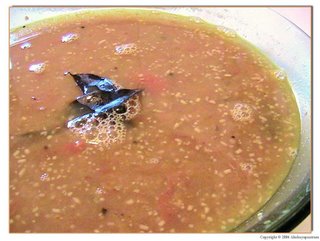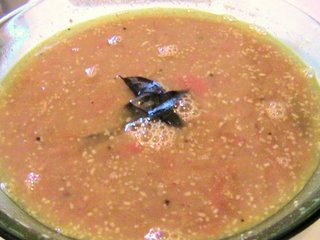In most South Indian homes sambar is a dish that finds a place on the meal table almost every day. Its a simple recipe that provides vegetarians our daily dose of protein without much effort. Everyone knows that Madras is ever so popular for its Sambar but almost every region in the South has its own adaptation of the recipe and the variations are endless. Some like it spicy while others add a touch of jaggery to sweeten it, in our home sambar does not contain tomatoes as a rule while it could be common ingredient in other homes. Ground coconut, freshly ground vs pre-ground sambar powder, simple onions to a whole array vegetables - pick a variation and you have a completely different flavor profile to relish.
No matter what the version though, Toor dal/kandi pappu/pigeon peas is the lentil of choice for sambar and also the most commonly used dal in the South. During the busy week day mornings, my mom had her routine perfectly planned. My dad left for work at 7:50AM on the dot and breakfast had to be made and a complete lunch packed for him. My brother and I left at 8:30AM and she left home at 8:50AM. It was rush hour every morning and just like the famous Mumbai dabbawala's, our very own dabbawali never missed a beat either. Every move in the kitchen was streamlined in order to get wholesome meal prepared for us. The cooked toor dal served two purposes - the thick mashed dal was added to the sambar while the dilute cooking liquid found its way into a warming rasam. My mom always adds a pinch of turmeric while cooking the dal in a pressure cooker but here it stains my stovetop and being the lazy one I avoid it altogether and add a few methi seeds and a pinch of asafoetida instead. A few drops of oil to the cooking water helps minimize foaming.
All you need for a comforting pot of sambar is a vegetable component which could be one or more of these - regular onions, pearl onions, carrots, bottlegourd(sorakaya), lady fingers (bhendi), brinjal, pumpkin, capsicum, potatoes, daikon radish (mullangi), drumstick (Munagakaya), chickpeas, fresh shelled broad beans, green peas. From the pantry you'll need tamarind, toor dal and some fragrant mom-made sambar powder! Thats it, you are just 30mins away from a bubbling pot of delicious sambar. Serve it simply with warm rice, dunk your idli's and vada's in it or serve it alongside hot upma or pongal and you have a wholesome meal to wrap your family around. I usually cook a double batch of toor dal and store it in the freezer so that on a busy week night dinner is really quick to put together.
Mom's Sambar PodiServing Size: ~2 cupsPrep Time: 20minsIngredients
Method
- 1 cup - Coriander seeds/Dhaniya
- 1 Tbsp - Channa dal/Senaga pappu
- 1 tsp - Fenugreek seeds/Menthulu
- 1/2 tsp - Mustard seeds/Aavalu
- 1" piece of dried turmeric root (optional)
- Red chilli powder - 1/2 the amount of spice powder got from blending the above ingredients
Notes: It you don't have dried turmeric root, skip turmeric all together and add a pinch of it when making sambar. The purpose of channa dal is to thicken your sambar.
- Dry roast coriander seeds on medium heat until fragrant. You don't want to brown or darken their color, once they become fragrant transfer to a plate to cool.
- In the same pan add the channa dal and dry roast until it begins to change color, transfer to the plate and cool. Repeat the step with fenugreek seeds, mustard seeds and turmeric root, roasting each individually.
- Once all the ingredients have cooled down, transfer to a blender jar and finely powder.
- Transfer to a air-tight jar, add in the chilli powder and blend it in with a spoon. It's going to be a challenge, but avoid taking a close whiff of the powder or you'll end up in a sneezing marathon!
- Don't let the fenugreek seeds turn dark or it'll make the powder bitter! Dried curry leaves can be added when preparing smaller batches.
-For my mom's rasam powder recipe check this post
Served with warm rice, a tiny drop of ghee and crispy popadams/vadiyam on the side will send me to a very happy place. Those who fear the smell of raw daikon will have no worries enjoying this sambar. The soft daikon becomes mellow in flavor and are a delight in the sambar. You can sneak in almost any veggie into a sambar and make it taste good.Mullangi /Daikon Radish SambarServings: 4-5Prep time: 30minsCooking time: 30minsIngredients
Tadka/Seasoning
- 1 cup - Daikon radish, peeled and sliced into rounds
- 3/4 cup - Toor dal, cooked and mashed
- keylime sized ball of tamarind pulp or 1/2 Tbsp store-bought tamarind extract
- 1.5 Tbsp - Sambar Powder
- 1/4 tsp - Turmeric powder
- 1 - Green chilli, slit lengthwise (optional)
- Salt to taste
- 2-2.5 cups water
Method:
- 1 tsp - Vegetable oil
- 1/2 tsp - Mustard seeds
- 4-5 - Curry leaves
- pinch of asafoetida/hing
- Optional - 1/4 tsp Cumin seeds & a dried red chilli
- Coriander leaves for garnish (optional)
Notes: If using vegetables like onions/brinjal/capsicum start by sauteing them in a Tsp of oil instead of cooking them in water in step 1. I like a really a tangy sambar and tend to use more tamarind extract, customize the recipe to suit your taste.
- In a deep saucepan, add a cup of water, sliced daikon, slit green chilli. Cover the pot and cook on medium heat until the radish slices soften a bit. You can use a microwave for this step.
- In the meantime, place tamarind pulp in 1/4 cup water and nuke it for 1 min. This makes the extraction of the pulp easier. Alternatively, soak the pulp in 1/2 cup water for 30-40mins. Using your hands, squeeze out as much of the pulp as possible and reserve.
- Once the radish slices are soft, add the tamarind extract, sambar powder, turmeric powder, salt and cook uncovered for 10mins or until the raw smell of the tamarind is lost.
- Mash the dal well and add it along with a cup of water to the sambar pot. Taste test for salt and cook for 8-10 mins more until slight foam forms on the top and you can smell the comforting fragrance of the sambar. Adjust the consistency by adding more water as needed and taste test for salt.
- For the seasoning, heat oil in the tadka pan, add mustard seeds, cumin and once they begin to splutter carefully add curry leaves and a pinch of hing. Pour this over the sambar and keep covered until its time to serve. Garnish with coriander leaves right before serving.
Now you tell me how you make sambar at home ?












 I hope all of you had a joyous holiday weekend. I made my first pie and stuffing this time! We weren't planning on it but I am glad I tried, they've been on my list of recipes to try for a very long time. I love pecan pie and V's fav is
I hope all of you had a joyous holiday weekend. I made my first pie and stuffing this time! We weren't planning on it but I am glad I tried, they've been on my list of recipes to try for a very long time. I love pecan pie and V's fav is 






 The browned garlic bits are very tasty and so are the tuvar lilva. They don't soften up totally like peas or lima beans and retain a slight bite which I really
The browned garlic bits are very tasty and so are the tuvar lilva. They don't soften up totally like peas or lima beans and retain a slight bite which I really 
 Ingredients:
Ingredients: and roll them up for the to-go person :)
and roll them up for the to-go person :) I also tried my hand at my mom's
I also tried my hand at my mom's 


 This has become my favorite dal recipe, and to think it is so simple to make ! After this recipe I have become a fan of the magical transformation a spoon of yogurt can lend to a dish, be it dal or a North Indian gravy dish. If you don't already do this, try it out today and turn your dish into a rich, creamy one without the need for any fattening heavy cream. Yogurt also tends to bring all the spices in the dish together giving you a smooth overall effect instead of a sharp individual feel. And not to forget, that it can also take care of that accidental, unintentional extra spoon of red chilli powder or garam masala in the dish ;-)
This has become my favorite dal recipe, and to think it is so simple to make ! After this recipe I have become a fan of the magical transformation a spoon of yogurt can lend to a dish, be it dal or a North Indian gravy dish. If you don't already do this, try it out today and turn your dish into a rich, creamy one without the need for any fattening heavy cream. Yogurt also tends to bring all the spices in the dish together giving you a smooth overall effect instead of a sharp individual feel. And not to forget, that it can also take care of that accidental, unintentional extra spoon of red chilli powder or garam masala in the dish ;-)





 This rasam has a wonderful medley of spices with pepper being the main source of 'heat' in the recipe, and this gives the warmth in the body when savored on a cold night. You can add a dried red chilli to the spice mix if needed. The rasam is also slightly thicker than the usual rasam but thinner than sambar. The freshly ground spices give a very distinct flavor to the the rasam, making the meal satisfying to the soul and the body. Do try it out and enjoy the winter night :-)
This rasam has a wonderful medley of spices with pepper being the main source of 'heat' in the recipe, and this gives the warmth in the body when savored on a cold night. You can add a dried red chilli to the spice mix if needed. The rasam is also slightly thicker than the usual rasam but thinner than sambar. The freshly ground spices give a very distinct flavor to the the rasam, making the meal satisfying to the soul and the body. Do try it out and enjoy the winter night :-)




